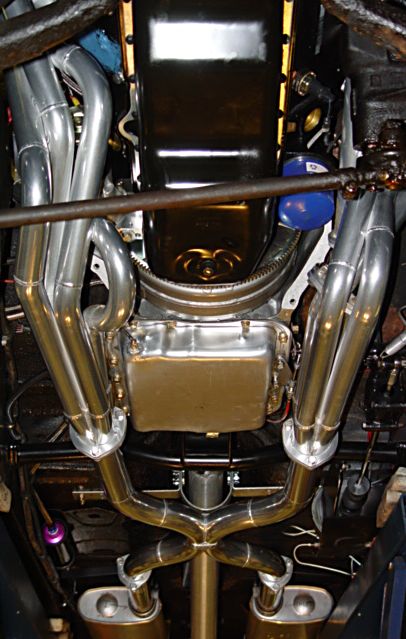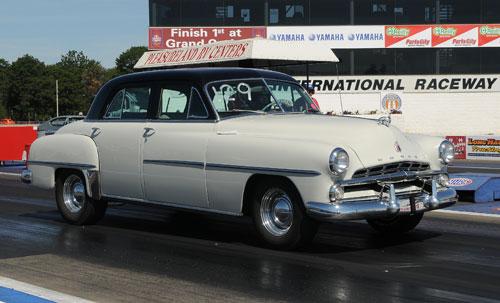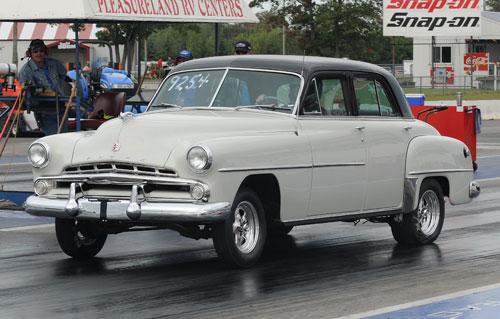| MY OLD DODGE - a personal quest to improve performance that might help you.
My Old Dodge - the car I built my first set of headers on in 1962.
This is my combined business and personal automotive and exhaust system Research and Development “project”. The car is a 1952 Dodge Coronet that my Dad bought brand new in February 1952. When Dad passed away in April 1954 my Mom saved the car so that I would have something to drive when I entered high school and eventually the University of Minnesota (Mechanical Engineering). I drove the car through high school, modified the stock engine (a waste of time and money I might add) and eventually, in 1962, I swapped in a new 340 HP 327” Corvette engine (before they were called crate engines) plus a Borg-Warner T-10 2.20 low 4-speed and a new ’62 Corvette rear end with 4.56:1 gears, Positraction, and sintered metallic brake linings. This is where I built my first set of HEADERS BY "ED"!!! The car ran pretty good considering all of the problems I also managed to incorporate into the car but near the end of the year I spun a rod bearing and then decided to get serious about making the car run harder at the drag strip. The new engine ended up with a roller cam, 13.5:1 pistons, magneto, lots of headwork, gears were changed to 5.38s, new clutch and 50 pound flywheel, etc. – plus a number of changes made to get rid of what I saw were bad design choices. Then I learned the hard way about car magazines NOT giving good advice because the “so much better” engine ran for crap and the biggest “accomplishment” obtained was cutting the gas mileage almost in half (from 7.5 MPG to 4 MPG!). Due to my disgust of trying so hard to do something well, spending ALL of my money and time in the process (thank God I didn’t have any credit cards back then!), and yet seeing everything turn to absolute shit plus a problem elsewhere in the world called Viet Nam (I ended up in the Navy), the car went into storage – with the engine and transmission sold. 43 years later, in October 2006, the car was moved out of storage (picture of car was taken after just being washed for the first time in 22 years - note that you can still see the towbar hooks just under the front bumper.) At this point the car had about 43,500 miles on it. My buddies and I looked over the situation and in December 2006 I purchased a 350 HP RamJet 350” port injected crate engine from Chevrolet. This time I decided to use a 700R4 (with a 2500 stall converter) to get an automatic with an overdrive and also changed the 5.38:1 rear end gears to more streetable 3.73s. The car is built to race NHRA “legal” – driveshaft loop, “tinned” area behind the rear seat due to fuel cell in trunk, exterior “kill” switch next to the right backup light, battery in right rear trunk corner, “puke” can, deepened oil pan, etc. While basically a "driver", I intend to drag race the car a number of times to further increase my exhaust system knowledge in a more personal way, to reinforce some exhaust design opinions I've had for years, to test out some other ideas and also answer some "questions" I’ve had a long time. Another thing about the car is that I plan on driving it to my 50th high school class reunion in October 2009. I wonder how many of my classmates will remember riding in the “old Dodge” back in the late 50s! (Later on - did so, picture of car outside building where reunion was held - farther down page.)
Just unwrapped - RamJet 350 - 350 HP, 400 lb-ft Torque - 350" Small Block Chev
Exhaust System Headers are 1 5/8" OD x 38" long with 3" Outlet Custom Collectors.
Exhaust System is ceramic coated 2 1/2" OD mild steel to Walker DynoMax
Once engine and transmission were installed, 4" aluminum driveshaft was made, headers and exhaust system were built, rear end gears were changed, etc., etc., engine was fired mid-August 2007. The car was then driven (and partially debugged) for about 1500 miles before going into the body shop. The Dodge is quite quiet (opinion of friends that have ridden in the car) but there is a nice "sound" coming out of the exhaust pipes so I am quite pleased with how the exhaust system and mufflers turned out in that respect.
Waiting for bumpers and tail lights. Note "kill" switch next to right backup light.
Bumpers and bumper guards have arrived but still waiting for other chrome parts. Top is original factory black. Bottom is an Urethane paint matched to the original color.
First time out with street tires (spun most of the way through first gear).
Dodge images used with permission of: Eagle Eye Photography/Barry J. Bergeron. Check their website (www.egleye.com) for more pictures of local racing action.
Second time out with M/T Slicks and Moroso Front Tires. NEW Air Tube (top) and OLD Air Tube The engine was originally supplied with the air filter clamped over the inlet of the throttle body (see engine picture above). I wanted the engine to pull air from ahead of the radiator so that the air would be cooler (denser) and thus cause the engine to develop a few more horsepower. While I had literally thousands of mandrel bends in the shop, none were big enough AND tight enough to clear the electric fan and the fan shroud on the backside of the radiator. With clearance issues as a primary concern, I looked around for bends (of ANY kind of material) and the 3" ID plastic plumbing pipe was the best "answer" I could find at the time and the lower cold air tube resulted.
Well, as you might guess, as a "header guy" - usually making/welding things out of metal tubing, I got a lot of "razzing" from friends and customers about "gluing" pieces of plastic plumbing pipe together to make my "air tube". I didn't care much for what I had done either but it was the best I could figure out at the time. Eventually I tracked down a much tighter metal bend, constructed the top air tube, and also changed to a different air filter too (a K & N #RC-4680). Relative to change, the new air tube has a 3 7/8" ID which represents an area increase of 67% and the filter area increased by 57%. (Also - while not visible in the photo, the plastic bend located closest to the throttle body had a terrible lip (or ledge) on the inside radius which had to hurt air flow yet I was careful that the inside radius in the same area in the new air tube did NOT have that same air flow problem!) (One thing I did learn about the old air tube at the drag strip was that when I removed the filter the car lost about one MPH! Apparently the filter causes the air to flow more efficiently into the tube resulting in a power gain. Interesting!)
At the drag strip - third time out (and keeping in mind that this car weighs 3875# at the track and is NOT put together to race) - the ETs dropped from a best so far of 14.02 to a best of 13.68, the MPH went from a best previous of 93.5 to a best of 96.85, and the 60' time dropped from a best so far of 1.88 to a best of 1.85. Solid 3 tenths off the ET, a gain of over 3 MPH and the 60' time even improved - +30 HP gain? Obviously, a 3" ID tube is QUITE restrictive on this motor - yet it is still larger than the ID of the throttle body. (Now I wonder if I should figure out how to make the air tube even larger OR figure out how to add a second air tube and merge it into the first tube at the inlet of the throttle body!)
The new air tube wasn't the only change I made prior to going to the drag strip, but the switch to Denso Iridium Spark Plugs (done to, hopefully, improve a terrible idle "quality" problem the engine has had from day one) didn't seem to make the engine idle any better so I doubt the new plugs made the engine perform any better either. The fuel pressure regulator had also been changed to a MagnaFuel unit as the factory regulator - when checked - seemed to have a mind of its own and appeared to somehow prevent the fuel line pressure from dropping when the intake manifold pressure was dropping (the two pressures are supposed to be "in sync" with each other as there is a hose that connects intake manifold pressure to the fuel pressure regulator). Since this "lack of sync" between both pressures was noticed primarily during part throttle movements, right now I see it as being more of a "street related problem". I don't see - at this time, anyway - that the new pressure regulator could have improved performance at the drag strip as that represents full throttle operation (high intake pressure) and I haven't seen anything that makes me think there are any fuel pressure issues relative to full throttle operation. (One thing that I intend to do in the near future is to rewire the connection to the fuel pump so that it, instead controls a relay in the back of the car so there is maximum voltage available to the fuel pump as the battery is directly above the fuel pump.)
Minneapolis, MN - South High School 50 Year Class Reunion Car parked outside Fort Snelling Officers Club - 10/10/09
By the way, this engine has MAJOR tuning problems relative to the fuel map in the computer and, what I believe from what I have seen so far (and I am DEFINITELY NOT an expert on this engine but...), is that this engine, to me, represents a "pretty piss-poor" example of product development on Chevrolet's part. I will go much further - in detail - as to my disappointment with this engine sometime in the future. At present, my advice to anyone considering the purchase of this engine is: DON'T! Build an LS series engine if you want injection and are willing to deal with any computer related issues that may come up. I have spent at least $2,000 more than I had ever expected to spend and hundreds of hours of time trying to understand why this engine idles so crappy with such a mild cam (196 degree intake valve duration at .050" lift), why it seems to "miss" (mis-fires) at idle and part throttle, and, in my opinion, doesn't perform as it should relative to its horsepower rating. (Maybe I'm wrong to expect this, and I realize that the car is different now - much higher rear end gear ratio and an automatic transmission with a relatively low stall speed convertor - but this car in 1962, when I was almost 21 years old and dumber than a post when it came to car performance and tuning, ran 100 MPH at the drag strip, going through the lights in THIRD gear with major traction issues at the starting line. AND, after the drag strip had closed for the season, I found out that the carpet under the throttle pedal had shifted so that the pedal motion was shortened considerably. It turned out that I had been actually racing with the secondaries of the two four barrel carburetors not even open - which explained why I couldn't get the spark plugs to "color" as I was just rejetting the secondaries at the drag strip! Once I corrected the throttle linkage motion problem, I took the car out for a spin and the gain was incredible - probably a 50-75 horsepower gain! Because the engine was running so lean at the drag strip, it was suffering from pre-ignition and detonation (but I was too dumb to know that), and the rods were, accordingly, being pounded out of round on the big end so that one of the rod bearings eventually spun - with less than 2000 miles on the engine!!!) I have also since learned (from somebody that has dyno'd an engine with the same intake manifold I used back then - as well as several other intake manifolds) that the intake manifold I was using at that time probably cost the engine about 25 horsepower because it's basic design (too low - NOT hi-rise) restricts air flow compared to a well designed hi-rise intake manifold.) If I had NOT replaced the factory intake manifold that came on the engine and also did NOT have the carb opening problem, I'm quite sure the car would have run 102-103 MPH back in 1962 NOW, forty plus years later, I have this new and, supposedly, technically superior (fuel injected, roller cam, better heads, etc.) larger displacement engine that doesn't even perform as good as the screwed up engine I had in this car before and that was also with my FIRST set of headers which I now know - from what I've learned about header design over the years - probably slowed the car down in 1962 by at least 2-3 MPH and a half a second in the quarter mile compared to what is on the car now!) Bummer!
More to be added later. K0406d_OKSMpfOKip
................................................................................................................................................................ |
|
|
MY OLD DODGE
A personal quest that might help you.
 |  | ||||






